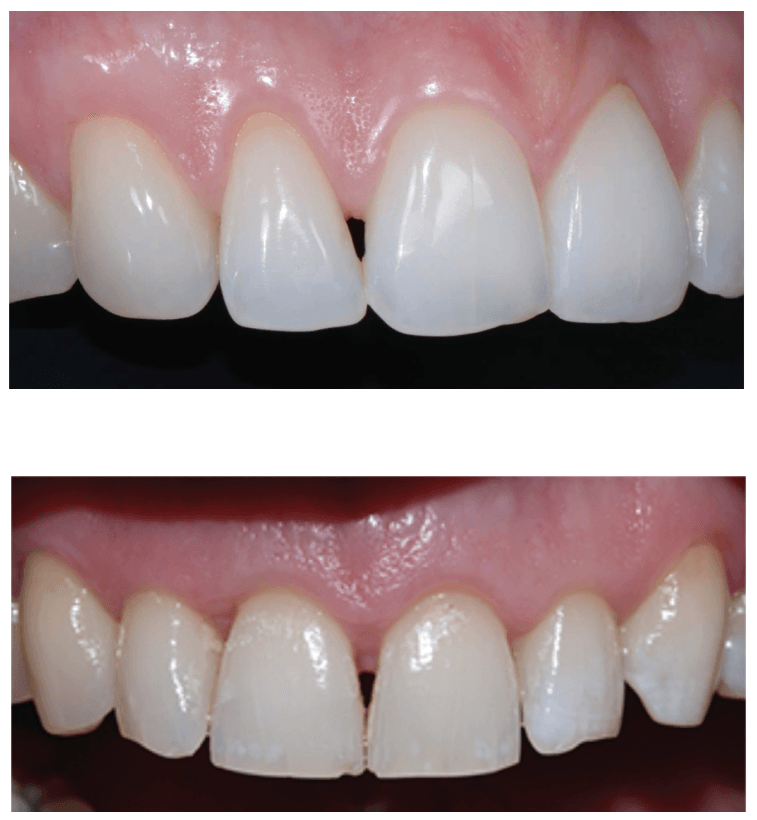Dr. Gregori Kurtzman writes about the products and techniques needed for careful interproximal contouring.
In part 1, Dr. Gregori M. Kurtzman discusses interproximal contouring techniques and considerations
Interproximal recontouring is a crucial component of orthodontic treatment that involves the careful reshaping of tooth surfaces where they touch. This procedure is essential for creating space for teeth movement, improving alignment, and enhancing overall smile esthetics.
Techniques for interproximal recontouring
Several techniques can be employed for interproximal recontouring, each suited to different clinical situations.


Diamond-coated disks
For cases where there is no overlapping of adjacent teeth, diamond-coated disks (Superflex, SS White, Lakewood, New Jersey) can be effectively used. These disks, available in single and double-sided options (Figure 5), are mounted on a slow-speed straight nose handpiece. To prevent accidental soft tissue injury, the use of a lip retractor is recommended. Due to the potential for soft tissue damage, the use of diamond-coated disks is primarily restricted to the anterior region (maxillary and mandibular).

When using a single-sided disk, the proximal surface of one tooth is modified first (Figure 6B), followed by the adjacent tooth after repositioning the handpiece 180 degrees (Figure 6C). For optimal results, the disk should be aligned parallel to the desired midline or vertical axis.

Diamond finishing strips
In cases involving crowding or the need for significant contact opening in posterior teeth, diamond finishing strips (Jazz Pro, SS White) are the preferred choice. These strips, available in coarse, medium, and fine grits (Figure 7), come in 4 mm and 2.5 mm widths to accommodate various clinical scenarios. The non-diamond coated center section of the strip allows for easy placement in tight contact areas.

To open a contact, the diamond abrasive surface of the strip is positioned at the tooth’s contact point. In posterior teeth, the strip is maintained parallel to the mesial or distal surface and gently pulled buccally and lingually to create a flat proximal surface. The strip is then reversed to modify the opposing proximal surface. To prevent food traps and facilitate subsequent orthodontic treatment, it is essential to avoid excessive reduction of the proximal contact area.
In the anterior region, where recontouring is aimed at correcting tooth width at the contact area, the strip is curved to follow the buccal-lingual curvature of the tooth (Figure 8B). The process is repeated on the adjacent tooth (Figure 8C).

When dealing with severe crowding, especially in the mandibular anterior, it is crucial to orient the strip to match the tooth’s proximal orientation being modified (Figure 9). This ensures a natural appearance following orthodontic treatment.

Bur and high-speed handpiece
In cases of extreme crowding, initial tooth reduction may be necessary using a bur in a high-speed handpiece before employing diamond strips. Fine-pointed diamonds and carbides are suitable for this purpose (Figures 10 and 11). This technique helps restore natural curvature and prevents the creation of an undesirable flat proximal surface. A flat proximal surface can create an illusion of continuous teeth, while a curved surface imparts a more natural appearance.


Conclusion
Interproximal recontouring is a valuable adjunct to orthodontic treatment that significantly contributes to achieving optimal esthetic outcomes. By carefully selecting and applying appropriate techniques, clinicians can effectively address crowding, diastema, and other dental irregularities, resulting in improved tooth alignment, spacing, and overall facial harmony.
Acknowledgement: The author would like to thank Robert Wojciechowski for his assistance with creation of the illustrations in the article.
This article was provided by SS White.
Interproximal contouring can provide positive esthetics. Read more about esthetic considerations in orthodontic treatment in this article by Dr. Thomas Sealey. Subscribers who pass the quiz can receive 2 CE credits! https://orthopracticeus.com/ce-articles/esthetic-considerations-for-the-adult-orthodontic-patient/
Stay Relevant With Orthodontic Practice US
Join our email list for CE courses and webinars, articles and mores

 Gregori M. Kurtzman, DDS, MAGD, FPFA, FACD, FIADFE, DICOI, DADIA, DIDIA, is in private general dental practice in Silver Spring, Maryland. He is a former Assistant Clinical Professor at University of Maryland in the department of Restorative Dentistry and Endodontics and a former AAID Implant Maxi-Course assistant program director at Howard University College of Dentistry. He has lectured internationally on the topics of restorative dentistry, endodontics and implant surgery, removable and fixed prosthetics, and periodontics. He has over 870 published articles, as well as several ebooks and textbook chapters. He can be reached at dr_kurtzman@maryland-implants.com.
Gregori M. Kurtzman, DDS, MAGD, FPFA, FACD, FIADFE, DICOI, DADIA, DIDIA, is in private general dental practice in Silver Spring, Maryland. He is a former Assistant Clinical Professor at University of Maryland in the department of Restorative Dentistry and Endodontics and a former AAID Implant Maxi-Course assistant program director at Howard University College of Dentistry. He has lectured internationally on the topics of restorative dentistry, endodontics and implant surgery, removable and fixed prosthetics, and periodontics. He has over 870 published articles, as well as several ebooks and textbook chapters. He can be reached at dr_kurtzman@maryland-implants.com.
